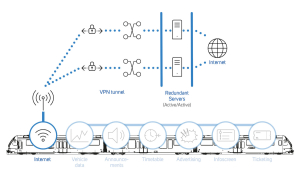IT Security vs. OT Security: What Are The Key Differences?
When most people think about cybersecurity, IT security comes to mind—but OT security is also crucial to protect digital assets and critical infrastructure.
As IT-OT convergence continues, bridging the gap between the two technology disciplines is crucial to create a comprehensive cybersecurity strategy that protects digital assets and safeguards critical infrastructure.
OT security and IT security are both essential aspects of this strategy. Let’s explore some of the differences and similarities between the two security approaches.
Scope & Focus
IT Security
When most people think about cybersecurity, IT security comes to mind. It protects an organization’s information technology systems—which include networks, servers, computers, devices and business data—from malicious activity, breaches, unauthorized access and other types of cyberattacks.
The goal of IT security is to maintain data integrity while protecting an organization’s sensitive enterprise data, ensuring confidentiality and stopping unauthorized users and devices from gaining access to corporate information.
In IT, critical security threats often include data breaches, intellectual property theft and other security incidents that could lead to financial loss, reputational damage or compliance issues.
OT Security
As opposed to securing enterprise systems, OT security secures industrial control systems, such as supervisory control and data acquisition (SCADA) systems. It also protects the physical processes and machinery that support a plant.
The goal of OT security is to prevent cyber-related issues that can cause operational disruptions. Unplanned downtime in an industrial environment can lead to lost production, missed delivery deadlines and inefficient use of staff resources.
It also aims to prevent the compromise of safety and control systems, as well as the disruption of essential services (think water, gas and electricity) or critical infrastructure, by guarding against breaches or attacks that can create safety hazards, equipment damage, physical harm or environmental risks. These can occur when cyberattacks manipulate settings or processes, tamper with systems or cause equipment malfunction.
Technology and Environment
IT Security
An IT environment is usually made up of general-purpose computing devices, such as laptops, desktops, printers, servers, cloud infrastructure, mobile devices and web applications. They can be found in almost any office.
As technology and needs change, the lifecycle of these devices tends to be short. They’re often updated or replaced every few years as they become outdated, less efficient or more vulnerable to security risks. As off-the-shelf devices, they usually run on common operating systems and are straightforward to replace.
IT security helps support use of these devices and systems for safe collaboration and file-sharing, internal and external communication and outreach, accounting and financial processes.
OT Security
An OT environment involves specialized devices like sensors, programmable logic controllers (PLCs), distributed control systems (DCSs) and industrial machinery. Instead of being housed in offices, these rugged devices can be found right on the plant floor as they support productivity, monitoring and control.
The lifecycle of OT systems tends to be longer than the lifecycle of IT devices and systems. OT systems may be purpose-built for specific applications or environments, running on specialized software and proprietary protocols. As a result, they’re not upgraded or replaced as often as IT equipment.
Real-time operations are critical in OT environments to make sure a plant can facilitate smooth processes, adjust to changing conditions and detect anomalies or hazardous conditions—all while keeping legacy systems and proprietary protocols in mind.
Risk Tolerance
IT Security
IT tends to be more dynamic and faster to respond to immediate threats through regular patching, software updates and vulnerability management. These are common IT practices to reduce the risk of cyberattacks.
Because IT environments typically include several similar types of devices, the same patch or upgrade can often be rolled out to many machines at once. They can also be scheduled during periods of office downtime to minimize productivity impacts.
OT Security
On the plant floor, safety and reliability are front and center. Anything that could potentially impact operations is approached slowly and carefully. The steps often taken in IT to reduce threats, such as immediate patching and running updates, aren’t as accelerated for OT due to constraints like specialized hardware, legacy systems and long lifecycles.
Scheduling downtime to install patches or updates can disrupt critical processes that may negatively impact production and safety. Because OT prioritizes production and physical safety, some vulnerabilities may remain unpatched for extended periods of time as teams assess complexity, compatibility and possible consequences.
Regulatory Landscape
IT Security
Depending on the business or industry, IT environments are often subject to specific industry standards and regulations covering data protection. Consider Payment Card Industry Data Security Standard (PCI DSS), which governs security practices for handling credit card data, or the Health Insurance Portability and Accountability Act (HIPAA) for patient health information and healthcare settings. Non-compliance can result in fines and penalties.
OT Security
Critical industries, such as energy, manufacturing, transportation and utilities, are subject to their own OT security regulations and standards. These compliance requirements often differ from traditional IT security regulations because they prioritize safety, reliability and availability of machinery and processes, with a goal of protecting equipment and infrastructure vs. databases or software.
Frameworks like the NIST Cybersecurity Framework SP 800-82 and IEC 62443 are used in some industries for guidance on things like risk assessment, security controls, incident response and reporting obligations.
Skillset and Expertise
IT Security
The professionals who work in IT security require a deep understanding of things like network security, endpoint protection, application security and data security. Because they work closely with data, networks and software, their knowledge lies in addressing traditional cyber threats, such as malware, phishing and unauthorized access.
OT Security
OT security professionals require a deep understanding of industrial processes, SCADA systems and ICS protocols. Because they work with physical processes and industrial systems, these professionals must have expertise in securing complex physical systems and mitigating cyber risks to equipment and infrastructure.
Helping You Strengthen OT Security
Belden and its brands, including macmon, can help you navigate IT-OT convergence so you can experience the benefits it offers, while reducing the risks it can bring to OT security and systems.
Our broad portfolio of industrial cybersecurity solutions offers visibility to and protection from events that threaten the safety, quality and productivity of control systems.
Find the original article here
Written by Patrick Deruytter








